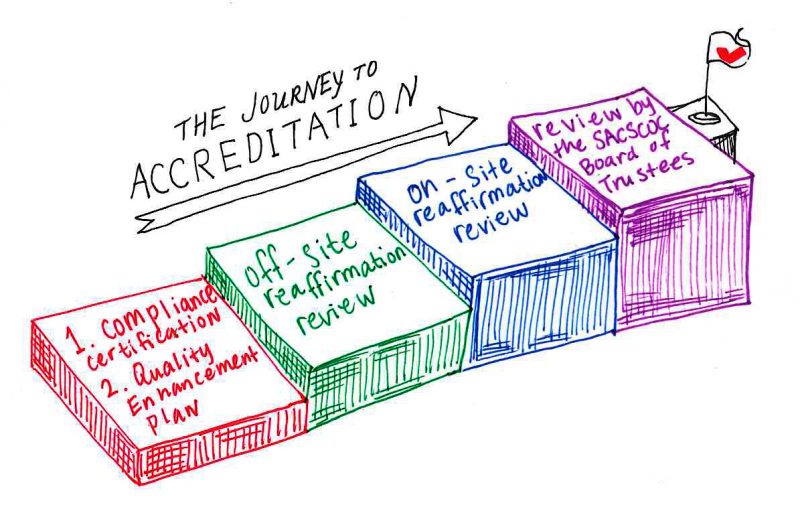Trinity University is in the process of being reaccredited by the Southern Association of Colleges and Schools Commission on Colleges (SACSCOC). Trinity has been accredited in San Antonio since Jan. 1, 1946, but every 10 years the university must go through a reaffirmation of accreditation.
Accreditation ensures that the university’s quality of education and facilities are deemed up to standards by either a regional or national accrediting body. Accrediting bodies act as the mediator between a university and the U.S. Department of Education and help reassure the government that a particular university is doing well.
Katherine Friedrich, director of assessment for Institutional Research and Effectiveness, is in charge of Trinity’s preparation for the SACSCOC reaffirmation along with Diane Saphire, the vice president of the office.
“The government has certain things that it asks us to provide — such as student achievement data — so they have a part in the process that way,” Friedrich said. “The regional accreditation bodies have worked very hard to convince the Department of Education that they’re doing a good job and making sure that we all are providing quality programs and meeting federal standards.”
SACSCOC has accredited Trinity for many years, but Trinity lost its accreditation after moving to San Antonio in the 1940s due to insufficient funds. Schools often lose accreditation due to financial troubles but can regain it several ways, including getting more students who pay tuition, getting more donors or investing endowments in ways that get higher returns.
“You have to show that you have the resources that are appropriate for your mission and your programs. So you can have smaller institutions that have a smaller bottom line, but as long as they can justify to SACSCOC that they are able to support their programs and fulfill their missions, then they’re OK,” Friedrich said.
Saphire leads the Trinity committee responsible for SACSCOC reaffirmation and led the previous SACSCOC reaffirmation 10 years ago. According to Saphire, SACSCOC is very egalitarian in nature.
“Everybody has to abide by the same set of standards,” Saphire said. “In many of these cases you have to justify what your mission is and then show that you are meeting your mission.”
In September, Saphire’s committee submitted SACSCOC documentation supporting Trinity’s compliance with about a hundred SACSCOC standards. This documentation was reviewed in November by an off-site team of representatives from other Southern colleges. While this team did not visit the campus, they reviewed the documentation that Saphire’s team had provided.
The team requested additional information for 17 of the standards; Saphire’s team submitted additional information on them to the on-site team in January. They read the new information and came to campus in early March.
According to Saphire, there are six additional standards that the SACSCOC reaffirmation team wants, so there will be one more round of documentation and assessment.
“It’s a three-stage process,” Saphire said. “They keep narrowing it down and narrowing it down to what you need to provide more information on, and so this is typical of the way that this process unfolds.”
The Quality Enhancement Plan (QEP) is a vital part of Trinity’s reaffirmation process. Universities affiliated with SACSCOC are required to release a new QEP every 10 years as part of the process. The university’s QEP 10 years ago focused on digital literacy as a response to the rapidly changing technological landscape.
This year’s QEP, Starting Strong, is focused on enhancing the academic experience for first-year students. Michael Soto, Trinity University vice president, is the QEP director.
The QEP aims to improve the overall first-year experience in teaching, advising and bolstering types of academic resources for first-year students specifically.
“We’re simply going to expand on what we already do by adding additional peer tutoring, student-led supplemental instruction in many courses — specifically in STEM fields. We’re also going to create a new Quantitative Reasoning and Skills [QRS] Center which will also be housed in the Tiger Learning Commons,” Soto said. “There’s going to be a full-time QRS Center director who will work with faculty and students.”
In addition to providing more quality academic resources, the new QEP also aims to center the first-year experience within campus culture.
“We’re also going to be working on making sure that all students get the message that it’s a sign of successful students to reach out for support,” Soto said. “We want to embed in the DNA of the university the idea that getting off to a great start as a first-year student is the key to being successful throughout the four years here and throughout students’ subsequent careers.”
The reaffirmation process will most likely be finished in December.







